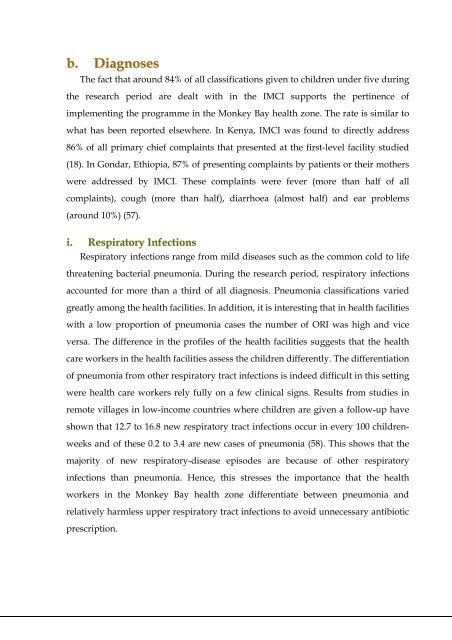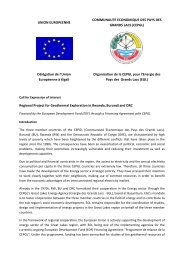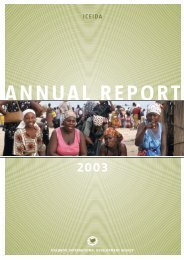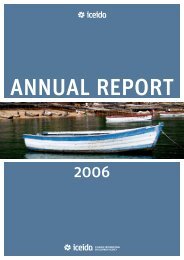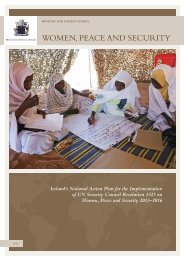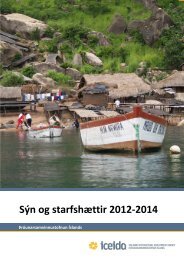The Implementation of Integrated Management of Childhood Illness ...
The Implementation of Integrated Management of Childhood Illness ...
The Implementation of Integrated Management of Childhood Illness ...
Create successful ePaper yourself
Turn your PDF publications into a flip-book with our unique Google optimized e-Paper software.
. Diagnoses<br />
<strong>The</strong> fact that around 84% <strong>of</strong> all classifications given to children under five during<br />
the research period are dealt with in the IMCI supports the pertinence <strong>of</strong><br />
implementing the programme in the Monkey Bay health zone. <strong>The</strong> rate is similar to<br />
what has been reported elsewhere. In Kenya, IMCI was found to directly address<br />
86% <strong>of</strong> all primary chief complaints that presented at the first-level facility studied<br />
(18). In Gondar, Ethiopia, 87% <strong>of</strong> presenting complaints by patients or their mothers<br />
were addressed by IMCI. <strong>The</strong>se complaints were fever (more than half <strong>of</strong> all<br />
complaints), cough (more than half), diarrhoea (almost half) and ear problems<br />
(around 10%) (57).<br />
i. Respiratory Infectionss<br />
Respiratory infections range from mild diseases such as the common cold to life<br />
threatening bacterial pneumonia. During the research period, respiratory infections<br />
accounted for more than a third <strong>of</strong> all diagnosis. Pneumonia classifications varied<br />
greatly among the health facilities. In addition, it is interesting that in health facilities<br />
with a low proportion <strong>of</strong> pneumonia cases the number <strong>of</strong> ORI was high and vice<br />
versa. <strong>The</strong> difference in the pr<strong>of</strong>iles <strong>of</strong> the health facilities suggests that the health<br />
care workers in the health facilities assess the children differently. <strong>The</strong> differentiation<br />
<strong>of</strong> pneumonia from other respiratory tract infections is indeed difficult in this setting<br />
were health care workers rely fully on a few clinical signs. Results from studies in<br />
remote villages in low-income countries where children are given a follow-up have<br />
shown that 12.7 to 16.8 new respiratory tract infections occur in every 100 childrenweeks<br />
and <strong>of</strong> these 0.2 to 3.4 are new cases <strong>of</strong> pneumonia (58). This shows that the<br />
majority <strong>of</strong> new respiratory-disease episodes are because <strong>of</strong> other respiratory<br />
infections than pneumonia. Hence, this stresses the importance that the health<br />
workers in the Monkey Bay health zone differentiate between pneumonia and<br />
relatively harmless upper respiratory tract infections to avoid unnecessary antibiotic<br />
prescription.<br />
43


